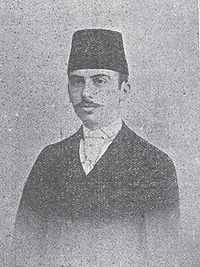Rauf Yekta Bey

Rauf Yekta Bey (1871–1935) was a Turkish musician, musicologist and writer on music.
Biography
Rauf Yekta Bey was born on 27 March 1871, in the Aksaray area of Istanbul, Turkey to his father Ahmed Arif Bey. Rauf Yekta spoke 3 languages: French, Arabic and Persian. He was a government official. Zeliha Han married Rauf Yekta Bey and they had two sons and two daughters.
Books
He wrote the first modern account of Turkish classical music available in a Western language ("La Musique turque", in Encyclopedie de la musique et dictionnaire du Conservatoire, Premiere partie, Paris, 1922 (written in 1913)). His emphasis in this encyclopedia was on intervals, modes and rhythms and quotes some 73 musical examples.
Present day theory of Turkish classical music is the result of collaboration by Yekta with Dr. Suphi Ezgi(1869–1962) and H. Sadettin Arel (1880–1955).
Notation system
Rauf Yekta introduced a modified European notation in his 1921 Lavignac article. Yekta's system used a variety of accidentals to express the microtonal inflections necessary for the Turkish modal system. This notational system was the one used for the official publications of the Istanbul Conservatory during the[1] 1920's and 1930's.
Musical career
Yekta performed often at Mevlevi ceremonies.
Notes
References
- Turkmusikisi.com – Biography of Rauf Yekta Bey (Turkish)
|